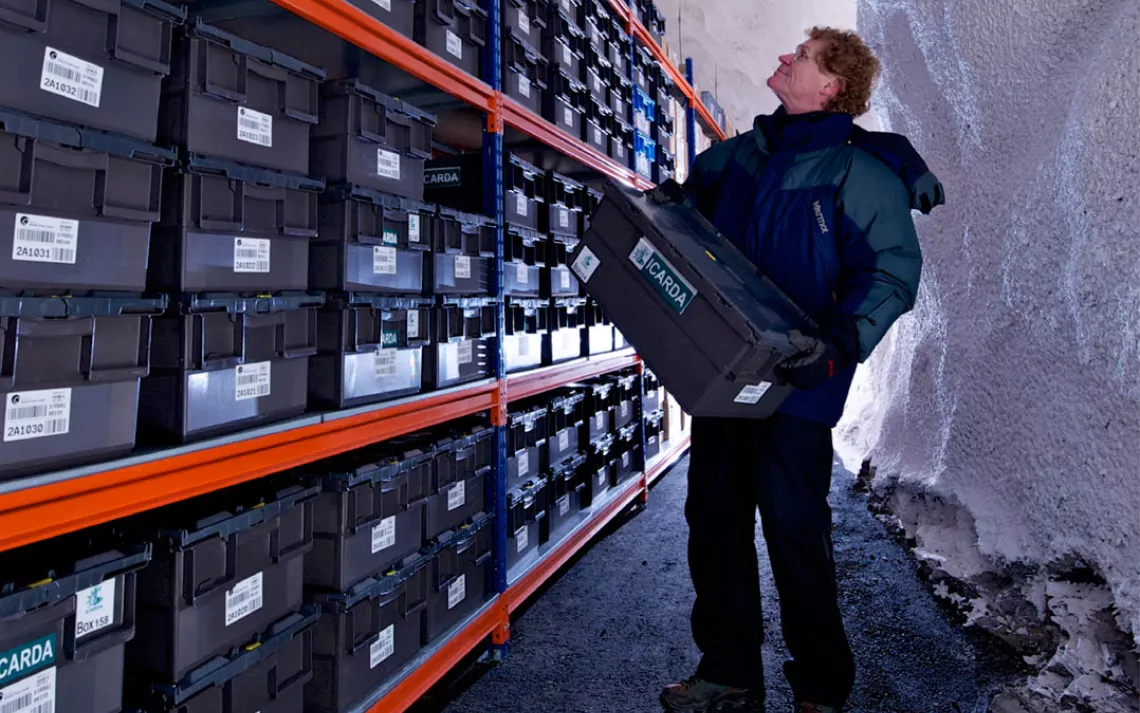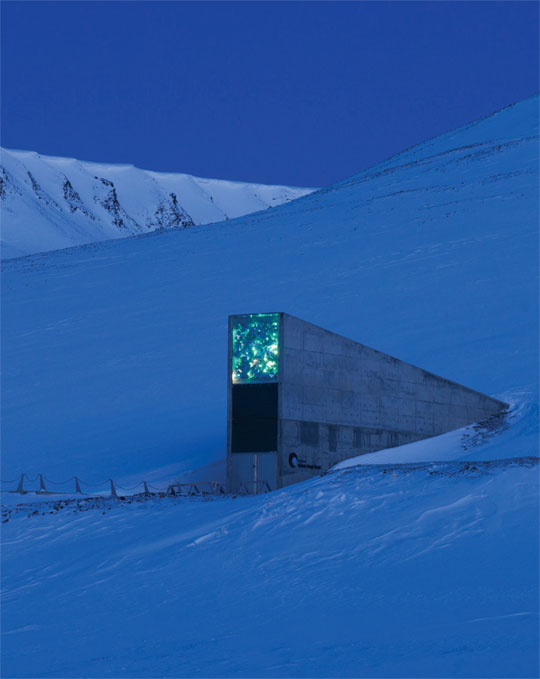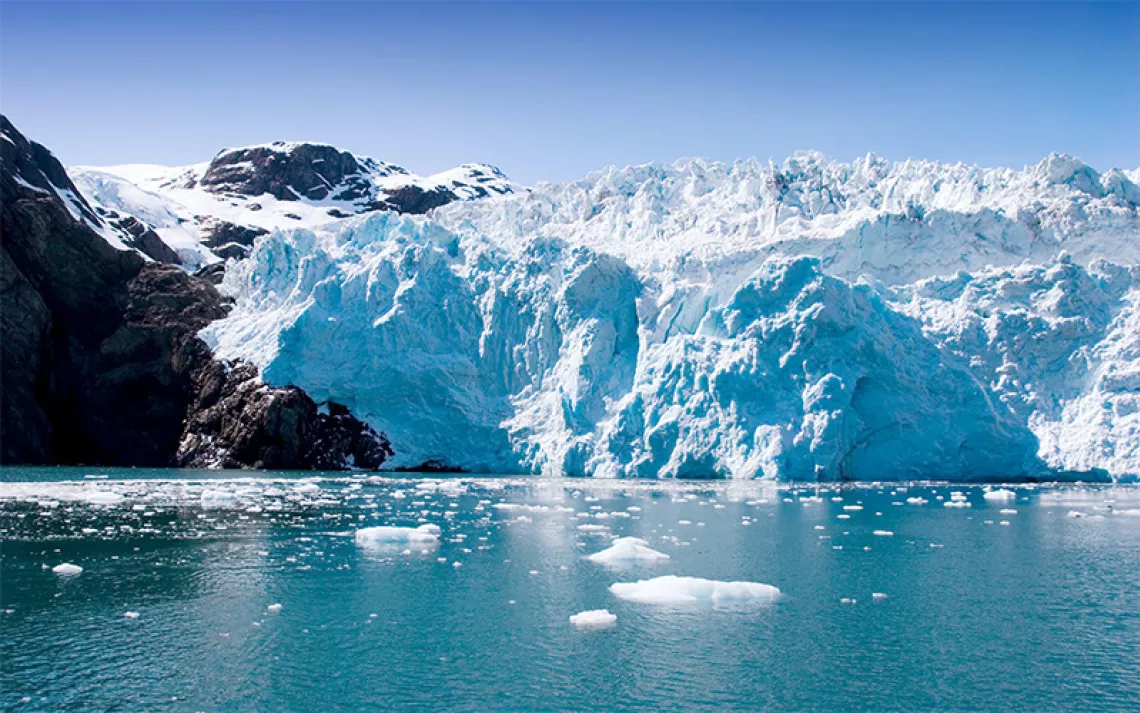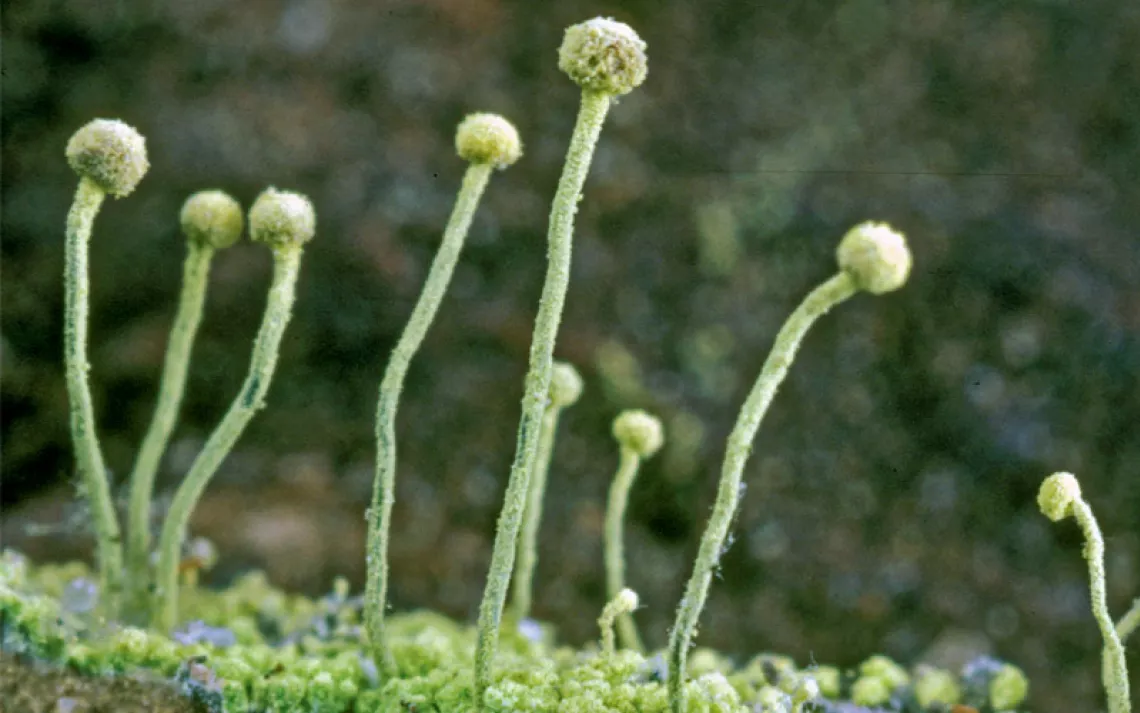Need for Seeds
Cary Fowler, the visionary behind the Svalbard Global Seed Vault, talks about his new book—and why biodiversity is a key component of world peace

Cary Fowler working in the seed vault | Photo by Jim Richardson
Food and crops occupy the front lines of climate change. “They cannot escape it,” writes Cary Fowler, biodiversity scientist, conservationist, and father of Norway’s Svalbard Global Seed Vault, in Seeds on Ice (Prospecta Press, September 2016). Fowler’s book offers a lush tour of his visionary vault, chiseled deep into a mountain near the North Pole, to store the seeds of 870,000 crop varieties from around the world, thus safeguarding civilization against the extinction of our most important natural resource: food. “[Seeds’] evolution, their adaptability to the environment, depends on us and on crop diversity—the stockpile of heat-tolerant traits found in genebank collections that plant breeders and farmers can employ to produce new varieties, better suited to new climates.”
Seeds on Ice illustrates this future climate—one marked by extreme temperatures, drought, floods, sterilized pollen, and a human population hike requiring at least a 50 percent increase in food production to keep pace. The seed vault was created in 2008 to maintain worldwide crop diversity, even in the event of rising sea levels, electricity outages (the mountain’s natural permafrost will keep seeds frozen), or terrorism (the structure was designed to absorb bombs’ shockwaves). It catalogs individually-plastic-sheathed “spare copies” of seed samples already stored in various national and academic genebanks around the world, meaning that in the event that a cooling system fails in the tropics, an earthquake strikes Europe, or political infighting leaves a given country’s seed bank vulnerable (war-ravaged Syria made the first withdrawal last year), those raw materials required for evolution and adaptation remain preserved. It’s helpful, Fowler writes, to think of the Global Seed Vault as an “insurance policy” for the future of global agriculture—a place where seeds are stored in airtight packets within a sub-18-degree Celsius climate, behind five locked doors.
Fowler's seed collection may have a reputation as a “doomsday vault,” designed to save us from apocalyptic natural disaster and nuclear war, but his book is far from a harbinger of doom and gloom. Rather, it serves as a thoughtful treatise on our debt to the world or plants, and our responsibility for their stewardship. It also offers a straightforward recounting of Fowler’s vision-turned-reality and, with plenty of stunning photography depicting frigid Svalbard and its surrounding polar bears and glacial shelves, makes for a beautiful addition to any coffee table.
To learn more about the importance of protecting agriculture systems to promote global security, I called up the humble, soft-spoken Fowler. I found the 67-year-old father, avid gardener, and native Tennessean-turned-Hudson Valley denizen personable, generous, a little puzzled about his vault’s incidental glamour (yes, it has been compared to a Bond villain’s secret Arctic lair), and most candid when it comes to the urgency of preserving crop diversity in the face of climate change.
What drove you to write this book?
In the beginning, a lot of people were writing about the seed vault, but not a lot of it was very accurate [laughs], so I thought, Gosh, somebody needs to tell this story, and I might be the only one who goes far back enough to tell it! Also, I’d long been working with Mari Tefre, the Norwegian photographer who documented the vault’s construction—she’d been up there since the beginning—and I didn’t think she’d gotten the credit she deserved. There are so many other people involved besides me, and I wanted their efforts to be recorded, so I thought, I’m gonna write a book that will showcase Mari’s photos in a comprehensive and logical way, integrate them into the text, and have an appendix that would really say thank you to the architects, construction workers, and people of Svalbard.

Outside of the Seed Vault | Photo by Mari Tefre
Seeds on Ice really grounds the reader in the culture of Svalbard. How did you decide to make it such a major part of the book?
Svalbard and its surroundings are so much a part of the seed vault’s story, and the scenery is so stunning, we could’ve made 10 books, all with different sets of photography. Most people will never see that environment, but I don’t think you can understand the seed vault without having a feel for the environment up there. When people visit the vault, I always say, you have to stay for at least three days—settle in at least slightly—to really feel a part of it. You really find yourself exploring new emotions when you’re in that environment. So, I thought it was important to try to give the reader a real sense of place.
The book offers such great historical context about seed-collecting and conserving. I’m curious as to whether any specific person or endeavor inspired you to create the vault.
The vault really came about toward the end of my career. I think sometimes people have a strange and somewhat warped sense of where ideas come from. They look at something like the seed vault and they’ll ask, Where’d you get that idea?! as if I’m some type of Einstein sitting at my desk and waiting for something to come out of the sky. When really, the context is, you’re just trying to solve a problem, and putting one foot in front of the other, and at some point it just kind of leads up to something. I’ve been in this field for about 40 years, and at least 35 of them went pretty unnoticed and unappreciated—can you imagine sitting down on a plane and being asked What do you do? and having to say, I work on preserving crop diversity? People would of course turn and face the window! So anyway, when the biodiversity-preservation thought process led to the seed vault, I didn’t think it was that big a deal, honestly. I never thought in my wildest dreams that the media would be interested—that did not occur to me. So in other words, it didn’t really feel like some gigantic breakthrough, which is why I wanted to break down and humanize its creation in the book. When my kids had school assignments they thought were so big, I used to tell them, Just break it down, and tackle one piece at a time. That’s how we ended up with the vault—we needed a place where seeds could be safe, where they could be cold. Now where could that be? [laughs]
Which crops would you say are most at risk here in the United States?
I don’t want to make any claims about whole crops becoming extinct like a dinosaur or something—crops will react differently in different regions, depending on the specific climate and environmental stressors—but there are a few crops I’d say are more on the edge than others. Certainly bananas are always cited, because the genetic base of their commercial trade is so small. When I worked for the UN in Rome, I gave a lecture to a fifth-grade class—it was the most wonderful lecture ever—and I asked if anyone could tell me what biodiversity was. And this one kid said, ‘There are two kinds. One is the diversity between whales and pandas and all the different kinds of species, and the other is the diversity within that species, and that’s what gives species the ability to evolve.’ And he was exactly right—it’s why extinction is a process, rather than an event. People get worried about mega fauna and whales and wolves, as if they’ll be gone forever when the last individual dies, but extinction is a process that unfolds as a species loses its ability to evolve. When it comes to our agricultural crops, people think, Is wheat gonna go extinct? Corn? But that’s not really the issue; the issue comes down to whether there’s enough diversity within wheat and corn to allow those crops to adapt to whatever challenges are coming down the road. And, since these are domesticated crops, their evolution is in our hands—it isn’t just taking place in the middle of the rainforest—so if we want them to not become extinct, we’re responsible for maintaining the diversity that gives us their traits; we’re responsible for the natural selection that renders them resistant to future disease. It’s on us, and that’s why we need this diversity—and it’s also why the seed vault was built to last forever.
Tell me about the process of withdrawing seeds.
The seeds remain under the ownership of the depositor—whichever institution supplied them. The government of Norway issues a contract to everyone stating that we at the vault claim no rights to the seeds, that really we’re just a safety deposit box for your seeds’ duplicates. Others won’t have access to your seeds; however, almost all depositors are party to a treaty to share their genetic resources with one another. So, say there’s a researcher in Brazil working on wheat who’d like to get a hold of some old varieties that have drought-tolerant properties. That researcher writes an institute that has them, say, in Aleppo, and says, I see your seed vault database here, and I’d like to sample some seeds. The Aleppo researchers would then have to go to their own bank and take out a few to send to Brazil. So, you don’t have to go to the North Pole to get the seeds you need in the event of a flood or tornado or war! Which is important, because crop extinction is not like losing your car keys—it’s something permanent, and it might involve unique traits that we’ll never see again. Which is just unacceptable in today’s modern world, when you consider how easy, and frankly how cheap, it is to preserve biodiversity. It’s a problem we can actually solve, and it doesn’t require any new tech or anything. Not too many world problems fall into the category of incredibly solvable [laughs].
How exactly does biodiversity empower society?
I don’t think we’ll solve any other world problems if we don’t solve this one. I’m concerned about climate and the demise of major aquifers, but we’re not going to solve those problems if our crops are failing because they’re not water-efficient and they’re not adapted to new climates. And I think a lot of important work is not going to be easy to accomplish in a world that’s at war with itself because people are going hungry—there’s a really strong correlation, after all, between hot weather and war and civil strife. Not because people get hot and bothered, but because agricultural systems are being stressed, and because people don’t take kindly to being hungry. Yes, biodiversity is a nice thing to care about, and it’s pretty and it feels good to be thinking about things being alive rather than extinct, but it’s also a national security issue. Not just for the United States, but also for countries and democracies all over the world.
What’s next for you and your biodiversity preservation efforts?
I’m involved with a delightful organization that started up in Oregon to preserve a temperate apple orchard—it’s a great example of how normal people can make a difference. It started with a man, Nick Botner, who assembled a collection of thousands of different apple varieties. He’s now in his 90s and having to make preparations, so volunteers have been grafting his varieties and transferring them to a new piece of land, where they can conserve them.
What are the biggest challenges biodiversity experts like yourself face today?
I’d say I’m most concerned about how we’re going to help subsistence farmers to adapt non-major crops. Not the wheat and corn and soybeans, but rather the smaller crops that might have a lot of regional significance in terms of food security. These crops’ evolution, from start to finish, has been in the hands of farmers, but now, given the pace with which the climate seems to be changing, we’re asking farmers to adapt their plants to dramatically new conditions that have never before been experienced in history, and we’re asking them to do it with very little diversity—Darwin would be puzzled!—so it behooves us to be rethinking the role of seed banks, specifically in terms of how we’re going to help subsistence farmers adapt those non-major crops, which collectively occupy more land than rice and wheat. I’m concerned about the major crops, too, but the minor crops get relatively little research and breeding attention.
Historically, until the mid-1980s, the way people increased food production was to cut down the forest for more cropland, but since then, the biggest increase in food supplies has come not from cutting down the forest, but rather from making agricultural production more productive, mostly through plant-breeding. So, if we want to protect the rest of the environment, we have to figure out, How are we gonna grow much more food from these minor crops—using less land, water, and nutrients—without actually producing more cropland? And that can only come about if we help the farmers to practice their own natural selection to adapt and improve their crop varieties. And that would represent a big institutional change on the part of seed banks—but one they should be thinking about.
What are your personal favorite crops to plant?
I live in upstate New York, and I try to practice what I preach, so I have a little apple orchard, with about 120 different varieties. We’re raising rare breeds of chickens and cows, and my wife writes books on heirloom varieties. She has one on squash, one on melons, one on tomatoes, and one on the way about peppers—she planted more than 500 varieties of peppers in the garden this year! I’m doing some amateurish crop breeding with lathyrus sativus, a grass pea, so we keep busy.
Do you have any advice for regular citizens who are concerned about preserving crop diversity?
That’s a really tough question, and in a way I don’t have an answer for it. Because the world really doesn’t need a thousand people doing what I do. Would it be good if people mobilized a little bit to educate their representatives in Washington about the importance of biodiversity, so that national seed banks don’t see more budget cuts? Yep, that would be good! Should people consider sensitizing themselves by growing and conserving heirloom varieties of fruits and vegetables in their gardens? Sure! But on the other hand, I see this effort as part of a larger picture of environmental conservation, of trying to practice justice in this world, as part of a larger human struggle to build food security, and to make this world more livable. And, if there’s some aspect of that goal that attracts or creates passion, then that’s what people ought to pursue. I don’t necessarily care if people work directly on this subject—though I guess it’d be nice to have a few more [laughs].
 The Magazine of The Sierra Club
The Magazine of The Sierra Club







